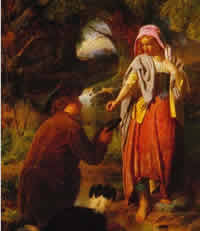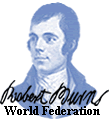|
Following
some exchanges with regular visitor to the site, Jessie Pettigrew, we
managed to coax her into writing an article on Burns relationship with
women. It is obvious to anyone who communicates with Jessie that she is
a lady of considerable knowledge, talent, wit and character and we are
delighted to share her writings with you. I'm sure everyone will agree,
Jessie has her own unique style. Thanks Jessie, for a well presented and
articulate piece !
The Lassies who Inspired the
Works of Robert Burns
by
Jessie S. F. Pettigrew F.S.A.(Scot.)
 Robert
Burns was born on 25th January 1759 and, naturally enough, the first of
the fair sex to enter his life was his mother - Agnes Broun. It was from
Agnes that Robert inherited his love of songs and rhyme as she would sing
to him when he was nocht but a bairn on her knee. She had learned these
songs while working in the fields as well as at the threshing. Many of
her songs were learned from Will Nelson, her old boyfriend, singing them
after him line by line until she got the tune right and knew all of the
verses. Robert
Burns was born on 25th January 1759 and, naturally enough, the first of
the fair sex to enter his life was his mother - Agnes Broun. It was from
Agnes that Robert inherited his love of songs and rhyme as she would sing
to him when he was nocht but a bairn on her knee. She had learned these
songs while working in the fields as well as at the threshing. Many of
her songs were learned from Will Nelson, her old boyfriend, singing them
after him line by line until she got the tune right and knew all of the
verses.
Some
of these songs had never been written down but passed by word of mouth.
The young Robert learned them too. Betty Davidson, an old friend of the
family who often stayed with them, was another of Robert's sources of
inspiration when he was very young. She would sit with the family around
the ingle and tell stories of witches and warlocks and recount many tales
of old legends and dastardly deeds. No wonder Robert, in later life, could
compose such a tale as that of 'Tam O Shanter'!
Burns
met his first young love when he was only fifteen, she being fourteen
years of age. Nelly Blair was her name and we know of her today as Nelly
Kilpatrick. She was the daughter of a local blacksmith and they met when
his father hired some extra help to bring in the harvest while they were
at the farm of Mount Oliphant. It was with Nelly in mind that he wrote
his first song "Handsome Nell" -
"O
once I lov'd a bonnie lass,
Aye, and I love her still;
And whilst that virtue warms my breast,
I'll love my handsome Nell."
Burns
wrote later of this song, saying -
"I
never had the least thought or inclination of turning poet till I got
once heartily in love, and then rhyme and song were, in a manner, the
spontaneous language of my heart. I remember I composed it in a wild enthusiasm
of passion, and to this hour I never recollect it but my heart melts,
and my blood sallies at the remembrance.".
However,
a year after his young romance had left him, Robert fell in love again
when he went to school in Kirkoswald for tuition in surveying. Next door
to the school lived
Peggy
Thomson with whom he became besotted. Peggy was housekeeper at Coilsfield
- the Castle of Montgomery - and Robert had met her frequently at Tarboth
Mill. They attended the same kirk and contracted an intimacy even although
she was engaged to
someone else, before the two of them ever met. Burns said "Peggy
was my Deity for six or eight months.". Ten years later, while he
was making plans to emigrate and when Peggy Thomson was quietly settled
as Mrs. Neilson at Minnybae Farm near Kirkoswald, Burns presented her
with a copy of his poems, a special one inscribed for her on the fly leaf
-
 "Once
fondly lov'd, and still remember'd dear, "Once
fondly lov'd, and still remember'd dear,
Sweet early object of my youthful vows,
Accept this mark of friendship, warm, sincere,
Friendship! 'tis all cold duty now allows.
And when you read the simple, artless rhymes,
One friendly sigh for him - he asks no more,
Who, distant, burns in flaming, torrid climes,
Or haply lies beneath th'Atlantic roar.
Alison
Begbie, the daughter of a small farmer in the parish of Galston, was not
a beauty
but had many charming qualities, heightened by an education much beyond
anything that Burns had ever encountered in a woman. They kept company
for a time, but, for reasons nowhere stated, Miss Begbie refused the poet's
suit. However, this did not stop him from writing of her in song - The
Lass of Cessnock Banks and Bonie Peggy Alison. He could find nothing to
rhyme with "Begbie" and used his poetic licence to refer to
her as "Peggy Alison".
Burn's
lovely song - "Mary Morison" - has caused much speculation as
for whom it was
actually written. Gilbert, the poet's brother, maintained that Alison
Begbie, Peggy Alison and Mary Morison were, all three, one and the same
person. It has been claimed,
however, that "lovely Mary Morison", whom the poet admired as
a girl of sixteen, was
the daughter of Adjutant Morison of Mauchline and in Mauchline Kirkyaird
there is a
tombstone bearing the following inscription - "In memory of Adjutant
John Morison, etc., etc.; also his daughter - the poet's bonnie Mary Morison
- who died 29th June, 1791, aged 20; and his second spouse etc.".
Who is right - Gilbert Burns or the tombstone?
"My
Highland Lassie, O" was inspired by Mary Campbell of whom Burns'
wrote the
following -
"My Highland lassie was a warm-hearted, charming young creature
as ever blessed a man with generous love. After a pretty long tract of
the most ardent attachment, we met by appointment on the second Sunday
of May, in a sequestered spot by the banks of the Ayr, where we spent
the day in taking farewell before she should embark for the West Highlands,
to arrange matters for our projected change of life. At the close of the
autumn following, she crossed the sea to meet me at Greenock, where she
had scarce landed when she was seized with a malignant fever, which hurried
my dear girl to the grave in a few days, before I could even hear of her
illness.".
 Mary
Campbell was dearly loved by Burns and, even in later years, he would
think of her fondly, sometimes being full of despair. His beautiful poem
"To Mary in Heaven" was written at Ellisland on the third anniversary
of her death. Jean Armour had noticed that towards evening, the night
before, her husband grew sad about something, and wandered solitary on
the banks of the Nith and about the farmyard in the extremest agitation
of mind, and though repeatedly asked to come in, declined the invitation.
On the lee-side of a cornstack he screened himself from the cutting edge
of the night wind and lingered till approaching dawn wiped out the stars,
one by one, from the firmament; he then entered the house, and sat down
and wrote his immortal address to "Mary in Heaven". Mary
Campbell was dearly loved by Burns and, even in later years, he would
think of her fondly, sometimes being full of despair. His beautiful poem
"To Mary in Heaven" was written at Ellisland on the third anniversary
of her death. Jean Armour had noticed that towards evening, the night
before, her husband grew sad about something, and wandered solitary on
the banks of the Nith and about the farmyard in the extremest agitation
of mind, and though repeatedly asked to come in, declined the invitation.
On the lee-side of a cornstack he screened himself from the cutting edge
of the night wind and lingered till approaching dawn wiped out the stars,
one by one, from the firmament; he then entered the house, and sat down
and wrote his immortal address to "Mary in Heaven".
"The
Lass o' Ballochmyle" was written in 1786 about Miss Wilhelmina Alexander,
sister of the proprietor of Ballochmyle. On 19th November, that year,
the poet enclosed the verses in a letter to Miss Alexander, in which he
wrote
"I had roved out, as chance directed, in the favourite haunts
of my Muse, on the banks of the Ayr, to view Nature in all the gaiety
of the vernal year. The evening sun was flaming over the distant Western
hills; not a branch stirred the crimson opening blossom, or the verdant
spreading leaf. It was a golden moment for a poetic heart. Such was the
scene, and such was the hour, when in a corner of my prospect I spied
one of the fairest pieces of Nature's workmanship that ever crowned the
poetic landscape, or met a poet's eye. The enclosed song was the work
of my return home, and perhaps it but poorly answers what might have been
expected from such a scene."
Much
to Robert's dismay, the lady took no notice, for the time being, of either
the letter or the song. Later, however, she set a high value on the bard's
compliments and on many occasions she showed off the song and letter together.
Miss Alexander died, unmarried, in 1843.
When
Burns was on his tour of the Borders in May of 1787, he visited the farm
of Berry-
hill, the home of his friends, the Ainslies. On the Sunday he accompanied
the family to
church. The minister gave out a text containing a heavy denunciation of
obstinate sinners. Seeing Miss Ainslie engaged in a search for the passage,
he asked for her Bible, and immediately wrote these lines on the inner
board -
"Fair
maid, you need not take the hint,
Nor idle texts pursue:
'Twas guilty sinners that he meant,
Not Angels such as you.
During
Robert's sojourn to Edinburgh in 1787, he met with Mrs. Agnes Craig or
McLehose, the daughter of a Glasgow surgeon and the wife of James McLehose,
a
writer in Glasgow. She was born in the same year as Burns and was living
in Edinburgh
with her two surviving children, having been deserted by her husband in
1780. They
corresponded as 'Sylvander' and 'Clarinda' and their writings to one another
could fill a
volume on their own. These letters were written in impeccable English
grammar and the use of the English language is outstanding. Some of Burns'
finest songs were written with Clarinda in mind, the best known being
-
 Ae
fond kiss, and then we sever; Ae
fond kiss, and then we sever;
Ae fareweel, and then for ever!
Deep in heart-wrung tears I'll pledge thee,
Warring sighs and groans I'll wage thee,
Who shall say that Fortune grieves him,
While the star of hope she leaves him?
Me, nae cheerful twinkle lights me;
Dark despair around benights me.
Miss
Jeanie Jaffrey, a daughter of the minister of Lochmaben, when but a girl
of fifteen,
inspired Burns to write two little-known songs - "I gaed a waefu'
gate yestreen", sometimes
known as "The blue-eyed lassie", and "When first I saw
fair Jeanie's face" - songs which are well worth reading. Jeanie
Jaffrey became Mrs. Renwick and went to live in New York.
Anna
Park was the niece of Mrs. Hyslop of the Globe Tavern in Dumfries and
she bore a
daughter to Burns on 31st March 1791. Jean Armour Burns, being pregnant
at the time, took the infant girl into her home and, ten days later, when
her own child William was born, she nursed the two of them together. Burns
composed "The gowden locks of Anna" and said of it that it was
the best love-song he had ever written.
Many
elegies, epigrams, epistles and epitaphs were written by Burns during
his short life-time and one elegy in particular was the "Elegy on
the late Miss Burnet of Monboddo". Elizabeth Burnet was the youngest
daughter of Lord Monboddo and Burns spoke of her with enthusiasm in many
of his letters. In one of his letters to Mrs. Dunlop he wrote -
"I
do not remember if ever I mentioned to you my having an idea of composing
an elegy on the late Miss Burnet of Monboddo. I had the honour of being
pretty well acquainted with her, and have seldom felt so much at the loss
of an acquaintance, as when I heard that so amiable and accomplished a
piece of God's work was no more. I have as yet gone no farther than the
following fragment, of which please let me have your opinion. You know
that Elegy is a subject so much exhausted, that any new idea on the business
is not to be expected; 'tis well if we can place an old idea in a new
light.".

Burns' admiration of Miss Burnet was very great indeed. This beautiful
young woman died of consumption in her twenty-fifth year in 1789.
Burns
wrote a charming song "Lovely Young Jessie" in 1793. The subject
was Miss
Jessie Staig, daughter of Provost Staig of Dumfries, who became the wife
of Major Miller of Dalswinton and sadly died at the early age of twenty-six.
Jean
Lorimer was the inspiration behind several of Burns' works and was referred
to as
"Chloris" and the "Lassie wi' the lint-white locks".
Until the end of August, 1795, she
continued to be the goddess of the poet's lyrical adoration. Her grave,
in Edinburgh,
remained unmarked until the Ninety Burns Club erected a suitable memorial
on the spot,
in the shape of an Ionic cross, bearing the inscription: "This stone
marks the grave of Jean Lorimer, the "Chloris" and "Lassie
wi' the lint-white locks" of the Poet Burns. Born 1775 - Died 1831.
Erected under the auspices of the Ninety Burns Club, Edinburgh, 1901".
Jessie
Lewars was the last of the fair sex to be immortalised by Robert Burns.
This young lady was the sister of John Lewars, the poet's friend and fellow
exciseman at Dumfries. During the poet's brief and fatal illness, Jessie
Lewars acted the part of a ministering angel in the Burns' household and
Burns seemed to imagine himself as the lover of his wife's kind-hearted
young friend. The tender and beautiful lyric of "O wert thou in the
cauld blast" was one of various tributes to young Jessie. According
to the lady's own statement, Burns called upon her one morning and said
if she would play him any favourite air for which she might wish new words,
he would endeavour to produce something that should please her. She sat
down to the piano, and played the air of the old ditty, already familiar
to him by his wife's singing and, after a few minutes' abstraction, he
produced the song - "O wert thou in the cauld blast". The last
four lines of this song must surely be the finest words of love ever written
-
Or were I Monarch o' the globe,
Wi' thee to reign, wi' thee to reign,
The brightest jewel in my crown
Wad be my Queen, wad be my Queen.
Jessie
Lewars became a Mrs. Thomson and died in 1855. Her remains, appropriately,
lie quite close to the poet's Mausoleum in St. Michael's Kirkyaird, Dumfries.
 This
insight into some of the lassies who inspired Robert Burns to write his
famous, and some not so famous, works would not be complete without the
mention of his beloved wife, Jean Armour Burns.Robert and Jean met in
the little town of Mauchline where he attended
the kirk, the ale house and the Masonic Lodge. He had set his sights on
marrying Jean and, although she was pregnant at the time, her father would
not allow the marriage of his daughter to a "worthless rhymer".
Burns was shattered by this stern attitude and was abandoned by his Jean.
However, two years later Burns and Jean were married, with her father's
blessing, as Burns had made a name for himself by this time and had been
accepted in the high society of the day. They set up home in Ellisland
Farm near Dumfries. In 1791 they moved from Ellisland to the Wee Vennel
in Dumfries where they lived happily until the poet died in 1796. The
house was purchased by their son, Colonel William Nicol Burns, on his
return from India. Jean and her family lived in this house until her death
in 1834. She was buried beside her husband in the Mausoleum in St. Michael's
Kirkyaird. This
insight into some of the lassies who inspired Robert Burns to write his
famous, and some not so famous, works would not be complete without the
mention of his beloved wife, Jean Armour Burns.Robert and Jean met in
the little town of Mauchline where he attended
the kirk, the ale house and the Masonic Lodge. He had set his sights on
marrying Jean and, although she was pregnant at the time, her father would
not allow the marriage of his daughter to a "worthless rhymer".
Burns was shattered by this stern attitude and was abandoned by his Jean.
However, two years later Burns and Jean were married, with her father's
blessing, as Burns had made a name for himself by this time and had been
accepted in the high society of the day. They set up home in Ellisland
Farm near Dumfries. In 1791 they moved from Ellisland to the Wee Vennel
in Dumfries where they lived happily until the poet died in 1796. The
house was purchased by their son, Colonel William Nicol Burns, on his
return from India. Jean and her family lived in this house until her death
in 1834. She was buried beside her husband in the Mausoleum in St. Michael's
Kirkyaird.
During
my research for this short piece I discovered that Burns was full of romantic
fantasy, never having spoken to some of the lassies of whom he wrote,
but members of the fairer sex he may have seen at a distance and whose
beauty filled him with passion. I also came to the conclusion that, although
he admired, respected and loved his wife Jean, he was in love with his
"Highland Mary" and remained so many, many years after her death.
It
would be impossible to mention all of the lassies who gave inspiration
to our National
Bard, some you may already have heard of, but those who have been mentioned
as well as those who have not, will remain immortalised throughout the
length of time - thanks to that genius of words - Robert Burns.
Auld Nature swears, the lovely dears
Her noblest work she classes, O;
Her prentice han' she try'd on man,
An' then she made the lasses, O.

Jessie
S. F. Pettigrew F.S.A.(Scot.)
|





